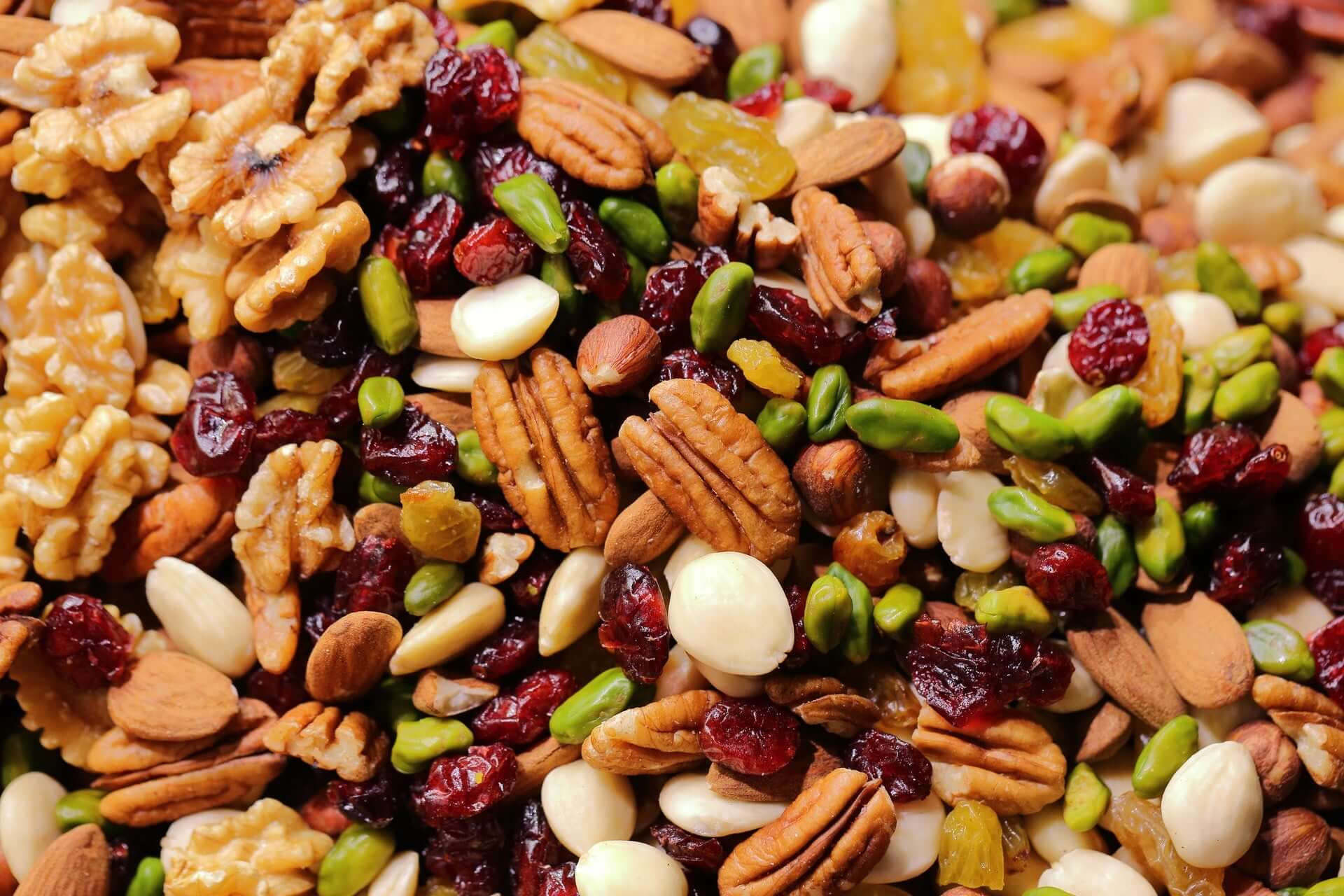
Inhaltsverzeichnis
Nuts - small, but Oho!
Everyone is advising us to eat more nuts. After all, they're so good for us. But why? And which nuts are particularly healthy?
Health benefits of nuts
Nuts are actually called nuts and, from a botanical perspective, are so-called inactive fruits, whose fruit wall consists of three woody layers. As you probably know, there are a whole host of different types of nuts: hazelnuts, walnuts, macadamia nuts, peanuts… But wait! Because Peanuts are not actually “real” nuts, but are legumes. Conversely, there are also nuts that we don't even know as nuts. For example, the hemp nut, which we know more as hemp seeds is known.
So what makes nuts so healthy?
Starting with protein and magnesium, above zinc and healthy fats to antioxidants and valuable trace elements: nuts are small powerhouses and contain all kinds of "good stuff." Some nutritionists therefore describe nuts as a "perfect compromise between meat and vegetables."
Each nut has its own specific benefits, which we'll discuss in more detail shortly.
What all nuts have in common is that they contain many Minerals and Vitamins The nutrients contained in nuts Antioxidants are essential because they "catch" free radicals and protect the body from cell damage. Nuts therefore strengthen our immune system.
Nuts are also particularly well-known for their positive effects on the health of our heart and digestion, skin and hair, and in regulating high blood pressure.
Some time ago, nuts were considered fattening due to their high fat content. Today, however, we know that the fatty acids contained in nuts are healthy fats which offer many health benefits. Here's a little more:
Omega-3 and omega-6 fatty acids regulate inflammatory processes in our body. While omega-6 fatty acids have a pro-inflammatory effect, omega-3 fatty acids act as the anti-inflammatory counterpart. To prevent inflammatory diseases, a balanced ratio of both fatty acids must exist in our body. A ratio of 2.5:1 (omega-6:omega-3) is considered inflammation-neutral. However, the average ratio in our population is 15:1! It is therefore important that we consume more omega-3 fatty acids and less omega-6 fatty acids (which, by the way, are found in large quantities in sunflower and soybean oil, as well as in animal feed, which we then also consume through meat.) Along with fish, nuts are a very valuable source of omega-3 fatty acids.
To keep our overall health in check, regular consumption of nuts is very beneficial. ☺️
What do I have to do when enjoying (😆) of nuts?
Because nuts also contain a lot of carbohydrates, they should be enjoyed in moderation. A handful of nuts a day is the generally recommended amount. The handful can consist of a variety of different types: z.B. 2 Brazil nuts, 2 walnuts, 3 almonds, 3 peanuts and 2-3 macadamia nuts.A mixture like this perfectly covers both our body's selenium needs and our daily vitamin E requirements.
You don't always have to eat nuts in addition to your other meals, but can also enjoy them instead of sausage or cheese. Nuts should also be always chew well.
When buying nuts, you should Organic quality and if possible also on Regionality Almonds, for example, originally come from the Mediterranean region; however, the largest growing areas today are in California, in the USA. This entails long transport routes, which is detrimental to CO2-print is of course not particularly good.
Often the nuts are already salted and/or roasted before purchase. However, it is best to untreated nuts It is also advantageous to whole nuts and chop them up as needed, otherwise they will quickly become rancid.
They can be enjoyed on their own as a snack, roasted and added to salads, used as a topping for a variety of savory dishes, or added to porridge or smoothies in the form of nut butter.

Photo by Marcia Cripps on Unsplash
Particularly healthy nuts and their respective benefits
Before I discuss specific nut varieties in more detail, I should point out that every nut has certain benefits, and no nut is truly unhealthy. I've decided to highlight five varieties that are particularly well-known for their health benefits and whose properties have already been extensively researched.☺️
1. Walnuts
Walnuts are among the most well-known types of nuts. A specific omega-3 fatty acid found in walnuts, ALA, strengthens the heart and has a positive effect on cholesterol levels. Their high zinc content is also worth mentioning, as this is important for a functioning immune system and wound healing.
Walnuts are often associated with our brains, and not just because of their appearance. Eating walnuts promotes blood circulation throughout the body, including the brain. However, other "brain-boosting" properties attributed to walnuts are currently largely speculative.
By the way, walnuts also grow in Germany.
2. Almonds
Strictly speaking, almonds aren't nuts, but stone fruits. They contain a lot of protein, vitamin B2, vitamin E, and magnesium. Vitamin B2 plays an important role in the defense against disease. Almonds also contain a significant amount of folic acid, which is especially important during pregnancy.
Almonds are available in a wide variety of forms in our supermarkets: chopped, ground, with or without the shell... Speaking of the shell: Many important nutrients, including fiber, are found in the almond skin. Therefore, if you want to get the full power of almonds, you should choose unpeeled, raw almonds.
3. Hazelnuts
It is one of the oldest nut varieties in Europe and is still native to our country today: the hazelnut.It's a true all-rounder: fiber, plenty of protein, zinc, iron, vitamin E, and healthy fatty acids… It's a shame that hazelnuts are so often underestimated!
Their ingredients protect our body cells from harmful influences, stimulate our digestion, and provide energy for our muscles.
Hazelnuts taste particularly good when roasted. Roasting causes the proteins to react with the sugars they contain, allowing their aroma to truly develop. In this state, they're perfect for salads or as a topping on baked goods. Please note, however, that roasting makes the unsaturated fatty acids more susceptible to damage and oxidation. Therefore, you shouldn't rely too often on roasted nuts. After all, unprocessed nuts are still best for our health. 🤗
4. Brazil nuts
Brazil nuts have enjoyed increasing popularity in recent years. While they've long been a staple in trail mixes, they've only recently become truly celebrated on their own or individually. The reason for the nut's growing popularity is its high selenium content. The trace element selenium protects against cancer by, among other things, binding and detoxifying heavy metals. This trace element is also important for the thyroid.
A selenium deficiency can be easily compensated for by consuming 1-3 Brazil nuts per day. In many cases, deficiency symptoms disappear after just 6-12 weeks.
Compared to other nuts, the Brazil nut contains more monosaturated fatty acids, which by no means makes it a “bad” nut.
Brazil nuts are mainly grown in Central and South America.
5. Cashews
This nut is rich in magnesium, potassium, iron, and protein. These ingredients help prevent cardiovascular disease and balance high cholesterol levels. They also contain the amino acid tryptophan, a precursor to the happiness hormone serotonin!
The abundant B vitamins found in cashews can help combat fatigue and concentration difficulties.
By the way, cashews are lower in fat than other nuts and therefore have fewer calories.
Which nut is your favorite? Let us know in the comments below this post! 🥜
If you would like to learn more about healthy eating, mindfulness, sustainability or family and pregnancy, Check out more exciting blog articles on these topics here.
Photo by Jenn Kosar on Unsplash



























Leave a comment
This site is protected by hCaptcha and the hCaptcha Privacy Policy and Terms of Service apply.